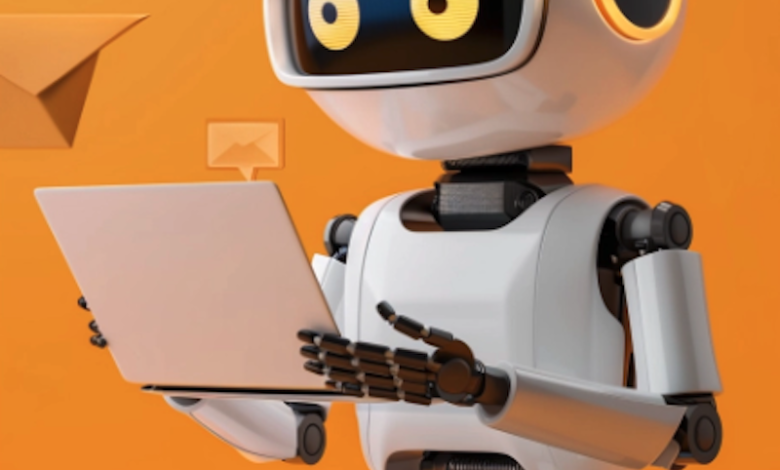How to Tell if an Email Was Written by AI – Robotics & Automation News

As artificial intelligence comes to the forefront more often, delineating whether a human or a machine with response-generating algorithms wrote an email takes on a heightened sense of importance.
Here, the main goal is to end the myths that make each minute code and its presence easier to identify. The comparison starts with the peculiarities in the language.
It continues with a discussion on syntax, an element that is uniquely human, being impossible to simulate in artificial intelligence.
In this way, people can detect the red color on AI text, proving their digital skills and awareness in an age where the state of the line between human language and artificial communication is more and more becoming part of everyday life.
How to Identify AI-generated Emails
The question of how to tell if an email is AI-generated is based on a superficial examination of stylistic and content anomalies. NLP strategies can extract the syntax and meanings of texts to produce the AI-based text.
Pay attention to the overused neutral greetings or the artificial formality that commonly exists in AI.
Ensure there’s a distinction between machine and human translation; and also inconsistencies or irrelevant information prove that automation is being used.
Cases of creating sentence complexity and vocabulary are often a sign of AI, especially when the language is unnatural.
Tools such as complex text analysis algorithms and computer models with machine learning capabilities can identify the presence of AI writing.
How to effectively use AI in email marketing
Artificial Intelligence’s capability in email marketing would make it possible to send customized emails, which is crucial in engaging clients.
One of the AI application’s talents in building highly complex algorithms allows for identifying consumer groups based on a trait and need type.
An AI knows the specialty of a particular case interaction to create an engaging text and thus deliver much-needed visibility to the message and the response it will generate.
AI-powered platforms such as AImReply go nicely with AI text writing operations, aiming to develop contextualized auto-generated content and make it sound human-made.
If these approaches are used, they would result in higher campaign success levels and help build the customer relationship.
Check out Free AI Email Writer – AImReply as this software can effortlessly help you with the most personalized and engaging emails.
How to Detect Plagiarism and AI-generated Content
AI-generated content detection is possible with special equipment that performs a fine-tuned analysis through the large bank of database profiles.
Find out how to detect plagiarism with software like Turnitin and Copyscape that compare submitted content to many websites online while the similarity will be detected.
This software uses algorithms to study text structure, language patterns, and semantic meanings, answering the issue “How can you tell an email may have been written using generative AI”.
Hence, the detection of duplicated or slightly rephrased sentences is made possible.
Apply AI recognition tools such as Grover or GPT-3 discriminator to outstand AI-detected content.
They are taught to go through this enormous set of data that unites human and AI-generated texts to distinguish the inaccuracies of style or logic and make them consistent.
These machine learning-based tools can have a great percentage of accuracy by grasping even the tiniest verbal hints and language nuances and organizing the content into human and machine.
Inaccurate and obsolete information
Fake or obsolete information given by AI-written emails causes serious mistakes that affect credibility and relationships.
AI is a data-driven process, so its outputs may be inaccurate if inputs are unreliable or outdated.
Email marketing, which consists of sending expired promotions or product information with wrong data, may develop customer anger and loss of trust.
Additionally, misinformation carried by the AI-generated email can result in the tarnishing of brand reputation.
Answering the question “how to tell if an email is AI-generated”, the main challenge is ensuring consistency and accuracy by maintaining an effective data auditing system and providing timely updates.
Insufficient depth and lack of personality
The missing depth and authenticity have become a hallmark of AI-generated texts. Usually, it leads to reduced listener engagement.
AI lacks human intuition and emotional intelligence. These abilities allow us to create authentic, lively, personal content.
The loss of authenticity in the ad types ruins the bond with the audience, and the audience cannot feel an interest in it.
Reaching this goal implies control of the human manual and individualizing the message, giving compassion and creativity, and adding human features to AI-delivered messages to build powerful relationships with motivated individuals.
Repeated language
Monotony is one of the hints that detects if the text comprises AI-created material.
In AI machine learning, algorithms repeat the same words and phrases and create some structures and patterns that are complicated and more itemized than the general human language.
The monotony accompanying this repetition can be seen in repetitive sentences that, among other things, might consist of redundant verbs, expressions, or nouns.
Besides, AI might also be due to language diversity and creativity. The fusing of humans and AI comes from finding the repetitive content that the AI-generated and the human-authored sentences share.
This would imply recycling a text to fill that deficit of an extraordinary article that should comprise originality, depth, and excitement.
Humans Persist as the Premier AI Detectors
Even though AI has made tremendous progress, humans are still the leading AI detectors.
While AI performs much better than humans in processing large amounts of data and generating content almost instantly, it has no such thing as intuition and contextual understanding, which are generally human capabilities.
The ability of the human mind to notice slight differences in language, emotion, or cultural nuances in a context where AI can evade them.
Human double-checking, verification, and evaluation of the machine-generated content complete the accuracy, authenticity, and aspects of relevance.
Following the question “How can you tell an email may have been written using generative AI”, humans can detect and correct any biases and mistakes carried through to the AI algorithms.
A combination of AI assets with the expertise of human beings results in synergistic effects, where the quality and effectiveness of decisions are significantly enhanced.
To Sum Up
The evolution of artificial intelligence has changed how people create and identify content; it is now unimaginable when they come up with new ideas and discover new works.
Although it takes such action at a high expense, alternative ways can be found, for instance, to separate AI and genuine content.
Yet, the integrity of this or that being irrelevant for the time being, the authority of humans is indeed the mechanism by which correctness is made effective by playing a reciprocating role.
AI-controlled tools are effective in categorizing data and pattern detection, but more is needed to suffice human insight and originality in creativity.
We aim to use AI capacity and express human emotions in developing our content and reach a conclusion that will ensure that the content we provide is authentic and stays current with the current trends.



